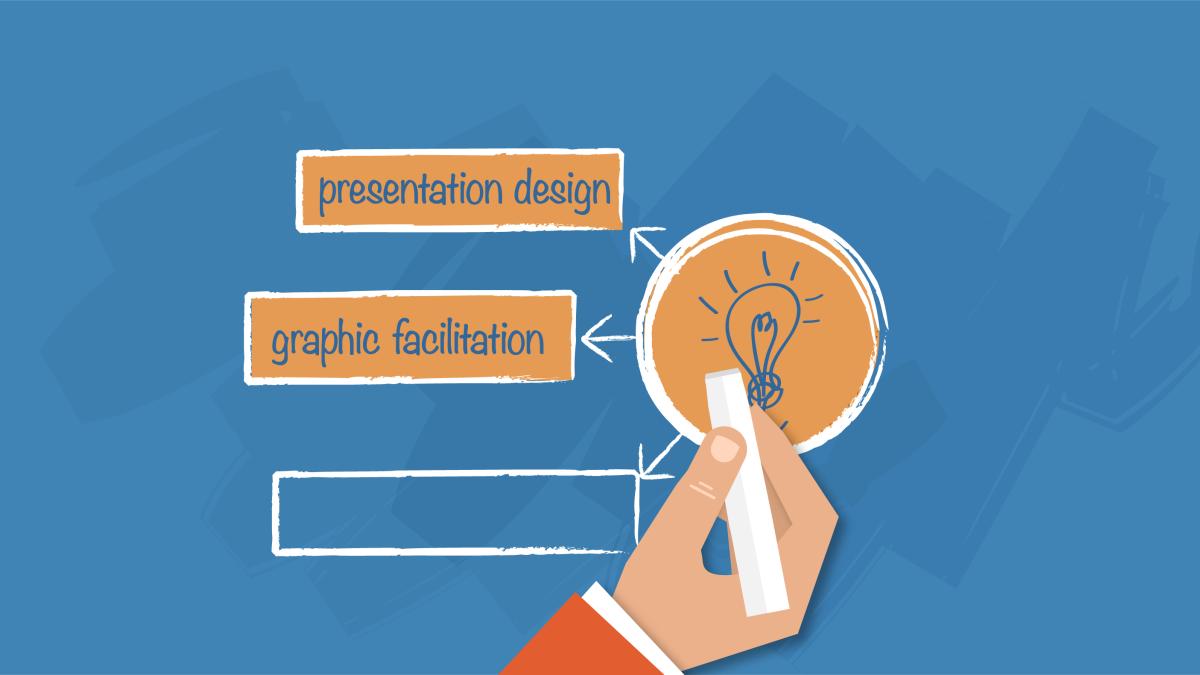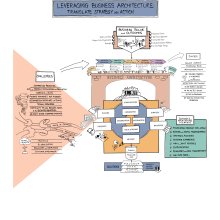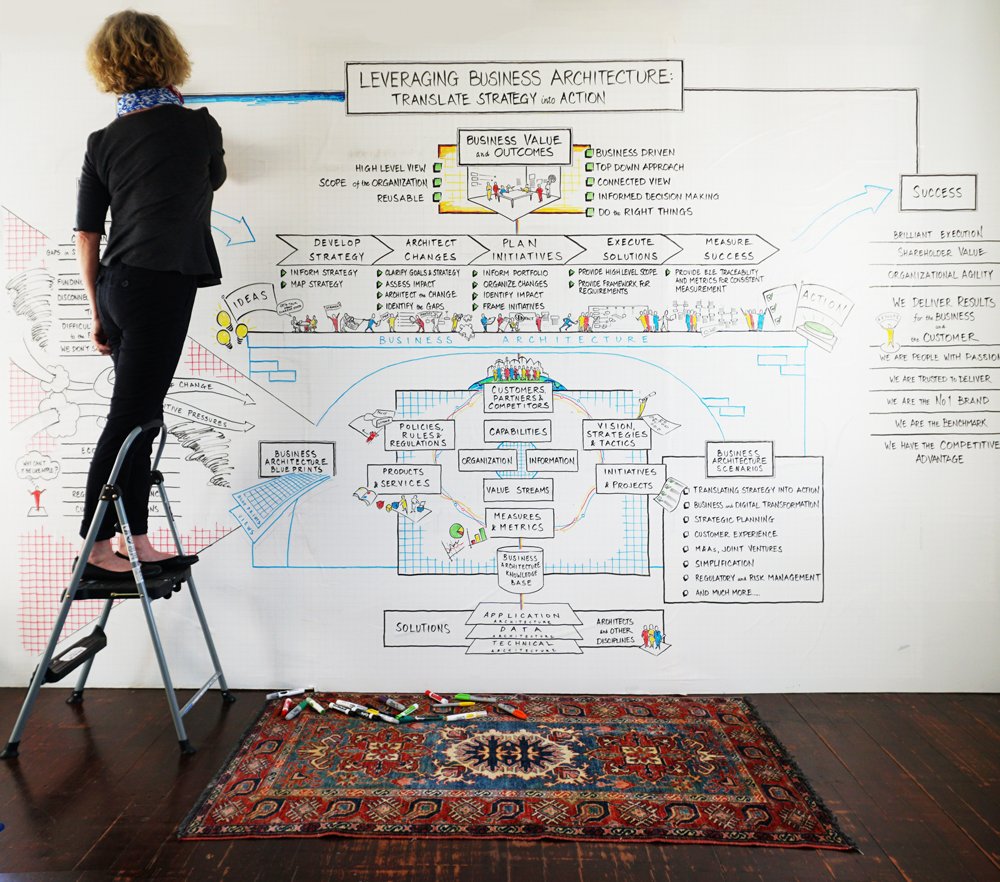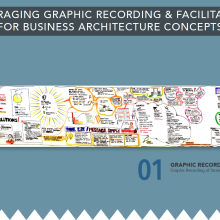Welcome to the second installment of our visual and storytelling StraightTalk series. This one is epic.
In this installment, we explore how we can leverage two highly engaging, visual techniques – graphic recording and graphic facilitation – as part of our business architecture practice. What we can achieve with business architecture is only as good as our ability to communicate, influence, and connect with other people. The two powerful illustrative techniques allow us to do so on a human level that raises our collective understanding.
We spoke with two masters on the topic, Sarah Greer and Michael Pemberton, and this post is a blend of both conversations. While we highlight the key points with our usual brevity, be sure to listen to the two podcasts featuring Sarah and Michael for their richness, color, and engaging stories. These are must-hear podcasts where and you can experience our guests’ mastery and passion for their profession.
Sarah Greer is a graphic facilitator, focused on working with Fortune 100 companies undergoing large-scale transformations. In our podcast interview, 5-Minutes with Sarah Greer, she grounds us on the foundational concepts and uses of graphic recording and facilitation. As you will see later on, Sarah demonstrated her graphic recording genius by creating an original masterpiece, exclusively designed for StraightTalk.
Michael Pemberton is an industrial engineer by training who has specialized in business architecture over his 25+ year career in both the corporate arena and consulting engagements. He is a rare and talented individual who heavily leverages graphic recording and facilitation as part of his strategy and business architecture practice. In our latest podcast installment, 15-minutes with Michael Pemberton, Michael shares with us how he learned these techniques as well as success stories from using these techniques in practice. You will see some of his examples later on in this post.
Here goes.
What exactly are these concepts of graphic recording and graphic facilitation? What are the differences between the two techniques?
Sarah: First, it’s important to note that the visual practitioners’ community is a very small and friendly group – and there is no official definition of these practices. So, here’s how I interpret them:
- Graphic Recording is essentially visual live capture of the content for an event or meeting. With this technique, there is little to no interaction between the graphic recorder and the speaker and participants.
- Graphic Facilitation also includes visual live capture of the content for an event or meeting, but the graphic facilitator serves as a guide throughout the entire meeting process. The graphic facilitator is instrumental in shaping the meeting, from influencing the agenda to selecting the right participants and venue. They also help co-design frameworks that support the right dialogue at the right time and of course help to guide or facilitate the conversation.
What is the value in leveraging these techniques?
Sarah: You know what they say – a picture is worth a thousand words. In today’s world of text, e-mail, Snapchat, and other social media platforms, people find themselves limiting the rich and holistic use of visual communications. So, the value of these visual techniques is that it brings people together – like a community – around a specific topic, challenge or opportunity. We can then shape the group’s view into what they might see if we fast-forwarded into the future.
When should we use them?
Sarah: Graphic recording works really well for conferences and events, such as for a keynote speaker, panel discussion or fireside chat. The graphic recorder creates an illustration that acts as a visual record of the session. It captures a moment in time.
Graphic facilitation is well-suited for situations when a group desires to become unified in a problem-solving context. For example, I worked with an organization that was struggling with their customer engagement model and needed to move from reactive to proactive. Graphic facilitation helped the key stakeholders to create a new vision, identify the implications to the business model and organization, and support communication and implementation for the change. Another example is for a start-up company that grew quickly, and though profitable, could not keep up with the pace of their own change. Graphic facilitation helped the team through a series of conversations which allowed them to see where they wanted to go, why and how they would get there.
Graphic Recording In Action — A Behind the Scene Look
What does graphic recording look like? Sarah created a 12 foot by 8 foot hand-drawn masterpiece for StraightTalk based on a one-hour webinar on Leveraging Business Architecture to Translate Strategy Into Action (guest access available for you to listen). Here are the results – and a handy visual of how business architecture enables strategy execution at the same time. Bonus. This artwork was the result of a collaborative engagement between Sarah Greer and our own Christopher Wray (Communiqué Marketing Solutions LLC). The final product, available here for download, is a digitized vector art conversion of Sarah’s original hand-drawn illustration.
Here is a glimpse behind the scenes with Sarah in action creating the original large-scale artwork.
Image
Why are graphic recording and graphic facilitation important for business architecture teams to leverage?
Michael: The truth is our models are not getting us where we want to go. At one point I realized that the models were just not communicating with the business and we needed to find something better. We needed something that was more like an “architect’s sketch of a house with a little bit of watercolor on it” that we use early on with the business to drive the vision of what we want to build, which eventually evolves into blueprints.
How can business architecture teams use graphic recording and facilitation?
Michael: Graphics are really an advanced form of communication. They are better than words. I use these techniques in four ways:
- Graphic Recording – I’ve found that graphic recording actually changes the way people in the room converse with each other. It causes them to realize that what they say could be represented graphically so they begin using word pictures.
- Co-Creation – When you get good enough at graphics, you can help people co-create solutions that they would have a hard time expressing otherwise.
- Graphic Facilitation – This method uses carefully planned exercises coupled with one or more well-designed “canvas” that help move a group towards their goal. As an active participant, you can get information out of peoples’ minds and in front of the group so that they can think about it as a whole.
- Animation – This is putting the graphics in an animated form so that people can see the parts of the picture come together. This allows them to gain a fresh understanding of the nature of the problem and arrive at new conclusions.
Can you give an example?
Michael: There are many examples of how I’ve used these techniques, but here’s one of my favorites. It’s from a quick service restaurant chain.
- The Situation: I was working closely with the strategy team and we needed a way to get the strategy down through execution in a seamless and painless fashion.
- What We Did: We decided to keep the business (and IT) architecture detail behind the scenes and insert a set of graphical models between the architecture and the business people. The graphic models did not look like technology, but were tied to all of the business and IT architecture models underneath. We scheduled some meetings with the business leaders and captured (graphically of course) various “vignettes” that described the challenges and what the future of the business should look like. Then we went into the strategy management process and put all of those vignettes up on the wall for feedback. It allowed the group to go through a deep thinking process using pictures, versus detailed documents which nobody had time to read.
- The Results: We compiled the vignettes and published a hardback, professionally bound, full color playbook for the future, which was used at the final strategy meeting. The pages were glossy, the lines were straight and the hand-drawn graphics had been converted to professionally designed graphics. It was so powerful that the CEO stood up at the end of the meeting and said “We have got to control every copy of this [playbook] because it would be like handing candy to our competition.” This practice continues at the company to this day.
Show and Tell: Using Graphical Techniques for Business Architecture
Here are a few examples from Michael’s portfolio, showing how he’s leveraged these graphical techniques for strategy sessions and the strategy management process (the playbook he referred to in his example).
Would the outcome have been different without these techniques?
Michael: I have a lot of experience doing business architecture and I’ve tried everything, so I can tell you exactly what would happen. We publish these models that few people want to look at, and those who do for the most part do not understand them. Therefore, those models are relegated to a place where they are never seen.
With full respect to the architecture discipline, the business does not understand or appreciate our models and there’s no way to make them – we have to meet them where they are at and that is what these graphics do. If we hadn’t used these techniques, the organization I described earlier would be nowhere near where they are as a restaurant company. They are where they are because we gave them that view of their future.
Can an architect learn to do this?
Michael: If you are reading this, you already have what it takes to do this. I’m mostly self-taught and I’m pretty much willing to learn anything that anyone is willing to teach me. I’ve worked with some great artists and learned everything I could from them. There are plenty of people out there who can help you.
Where do we start?
Sarah: Just get started. Practice lettering on a wall or a flipchart. The important thing is to get comfortable, so like anything else, the more you practice the more it will just become second nature.
There are many, many books on the subject of graphic recording and graphic facilitation. My top three picks: The Graphic Facilitator’s Guide, Visual Meetings, and Gamestorming. There are also many practitioners, like myself, that can host workshops and teach the basics. It’s great fun – and can double as a terrific team-building exercise.
Michael: I’ve learned from Sunni Brown, who is a constant inspiration to me and I’m part of The Doodle Revolution. I learned from Nancy Duarte and her book Resonate. I think if I could go around again in this life, I’d come back as Nancy Duarte. I have every book by David Sibbet, who is a certifiable genius in this area, and I use his material constantly. Milly Sonneman and her Beyond Words book inspired me early on when I thought there was just no way I could do this. I also e-mailed a lot of professionals and asked them how they created some of their pieces. The people in this community are so open and willing to share.
It takes very little for you to begin to learn how to draw. Start with your own notebook and have a goal to replace 10% of your words with graphics. Then work up to 20%. Then pick a meeting and go up to the whiteboard and start drawing what you hear in the room.
In Closing…
Sarah: Having been doing this for quite some time, I am always so pleasantly surprised in how people reach and are astonished at the simple act of drawing out their thinking. It is remarkable to see people making connections because they have line of sight in one room to all the content that was created in a day. And I never get tired of hearing “I never thought we’d get so much done in one day.”
Michael: There was a time when we all doodled and drew pictures – and we wanted them on the board at school and our refrigerators at home. That worked fine until one day perhaps a teacher found you doodling and told you to stop drawing pictures and get to work. Maybe you put aside that skill for whatever reason. But it’s there and you can pick it up and start again. The hardest thing to overcome is your own internal critic. But go out there and get to work. You have this ability and these graphics appeal to you for a reason, and that’s because you think this way. Everybody can do this and I encourage you to start tomorrow.
More Good Stuff…
5-Minutes with Sarah Greer: How Business Architecture Practices Can Leverage Graphic Recording and Facilitation For Greater Success–Part 1 (StraightTalk podcast): Sarah’s podcast is a must-listen for a chance to learn the what’s and why’s of graphic recording and graphic facilitation from a true master.
15-Minutes with Michael Pemberton: How Business Architecture Teams Can Leverage Graphic Recording and Facilitation for Greater Success – Part 2 (StraightTalk podcast): Don’t miss Michael’s brilliant podcast, in which you will hear real success stories of how he’s used graphic recording and graphic facilitation as part of his architecture practice.
The Graphic Facilitator’s Guide: How to use your listening, thinking and drawing skills to make meaning (book by Brandy Agerbeck): Learn guiding principles to listen deeply, think critically and draw swiftly to make great work happen.
Visual Meetings: How Graphics, Sticky Notes and Idea Mapping Can Transform Group Productivity (book by David Sibbet): This book explains how anyone can implement powerful visual tools and gives you a slew of exciting tricks and tools to leverage.
Gamestorming: A Playbook for Innovators, Rulebreakers, and Changemakers (book by Dave Gray, Sunni Brown and James Macanufo): A fantastic resource with more than 80 games to help you break down barriers, communicate better, and generate new ideas, insights, and strategies.
- Also check out the online Gamestorming Toolkit. Score!
The Doodle Revolution: Unlock the Power to Think Differently (book by Sunni Brown): A fearless guide to awakening your mind using simple visual language.
- Also check out the Visual Summary of the book. It’s an infodoodle on a book about infodoodles. Whoa, that is meta.
Resonate: Present Visual Stories that Transform Audiences (book by Nancy Duarte): How to make a strong connection with your audience and lead them to purposeful action – and convey content with passion, persuasion and impact.
The Blog (Nancy Duarte): Amazing resources and blog from Nancy Duarte.
Beyond Words: A Guide to Drawing Out Ideas (book by Milly R. Sonneman): This colorful, offbeat business guide shows how to add zip, interaction, and excitement to just about any kind of meeting or presentation. Even if you can’t draw a straight line, this book will have you doodling away like a pro in no time flat.
The Back of the Napkin: Solving Problems and Selling Ideas with Pictures (book by Dan Roam): How to clarify any problem or sell any idea using a simple set of tools. Drawing on a humble napkin can be more powerful than the slickest PowerPoint presentation.
Shape Your Thinking (TED Talk): An excellent (and visual) TED Talk by Brandy Agerbeck who reshapes our thinking about drawing.
Doodlers, unite! (TED Talk): A light TED Talk by Sunni Brown that makes the case for unlocking your brain via pad and pen.



